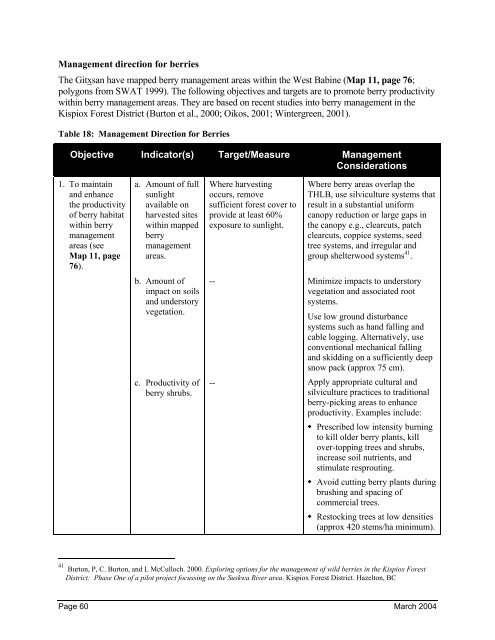West Babine Sustainable Resource Management Plan
West Babine Sustainable Resource Management Plan
West Babine Sustainable Resource Management Plan
Create successful ePaper yourself
Turn your PDF publications into a flip-book with our unique Google optimized e-Paper software.
<strong>Management</strong> direction for berries<br />
The Gitxsan have mapped berry management areas within the <strong>West</strong> <strong>Babine</strong> (Map 11, page 76;<br />
polygons from SWAT 1999). The following objectives and targets are to promote berry productivity<br />
within berry management areas. They are based on recent studies into berry management in the<br />
Kispiox Forest District (Burton et al., 2000; Oikos, 2001; Wintergreen, 2001).<br />
Table 18: <strong>Management</strong> Direction for Berries<br />
Objective Indicator(s) Target/Measure <strong>Management</strong><br />
Considerations<br />
1. To maintain<br />
and enhance<br />
the productivity<br />
of berry habitat<br />
within berry<br />
management<br />
areas (see<br />
Map 11, page<br />
76).<br />
a. Amount of full<br />
sunlight<br />
available on<br />
harvested sites<br />
within mapped<br />
berry<br />
management<br />
areas.<br />
b. Amount of<br />
impact on soils<br />
and understory<br />
vegetation.<br />
c. Productivity of<br />
berry shrubs.<br />
Where harvesting<br />
occurs, remove<br />
sufficient forest cover to<br />
provide at least 60%<br />
exposure to sunlight.<br />
Where berry areas overlap the<br />
THLB, use silviculture systems that<br />
result in a substantial uniform<br />
canopy reduction or large gaps in<br />
the canopy e.g., clearcuts, patch<br />
clearcuts, coppice systems, seed<br />
tree systems, and irregular and<br />
group shelterwood systems 41 .<br />
-- Minimize impacts to understory<br />
vegetation and associated root<br />
systems.<br />
Use low ground disturbance<br />
systems such as hand falling and<br />
cable logging. Alternatively, use<br />
conventional mechanical falling<br />
and skidding on a sufficiently deep<br />
snow pack (approx 75 cm).<br />
-- Apply appropriate cultural and<br />
silviculture practices to traditional<br />
berry-picking areas to enhance<br />
productivity. Examples include:<br />
Prescribed low intensity burning<br />
to kill older berry plants, kill<br />
over-topping trees and shrubs,<br />
increase soil nutrients, and<br />
stimulate resprouting.<br />
Avoid cutting berry plants during<br />
brushing and spacing of<br />
commercial trees.<br />
Restocking trees at low densities<br />
(approx 420 stems/ha minimum).<br />
41 Burton, P, C. Burton, and L McCulloch. 2000. Exploring options for the management of wild berries in the Kispiox Forest<br />
District: Phase One of a pilot project focussing on the Suskwa River area. Kispiox Forest District. Hazelton, BC<br />
Page 60 March 2004

















